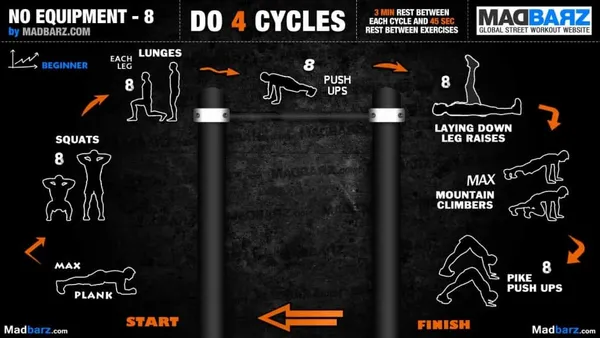Table of Contents
Are you ready to embark on a transformative fitness journey with calisthenics? As a beginner, you may be eager to dive right in, but it's crucial to approach this discipline with a solid foundation. At Kizworld, we believe in empowering individuals with the knowledge and guidance they need to achieve their fitness goals. In this comprehensive guide, we will provide you with a step-by-step calisthenics beginner workout plan, tailored to help you build strength, improve flexibility, and enhance your overall well-being. Whether you're a complete novice or have some prior fitness experience, this workout plan will provide you with a safe and effective way to get started with calisthenics. So, get ready to unlock your fitness potential and experience the incredible benefits of this bodyweight training method!
Calisthenics Beginner Workout: A Comprehensive Guide to Get You Started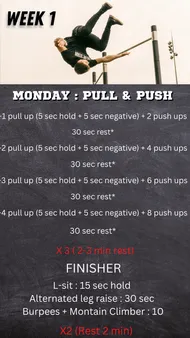
Benefit | Description |
|---|---|
Improved Body Composition | Calisthenics helps burn fat and build muscle, leading to a leaner and more toned physique. |
Enhanced Strength and Power | Bodyweight exercises challenge your muscles, increasing strength and explosive power. |
Improved Flexibility and Mobility | Calisthenics movements require a wide range of motion, enhancing flexibility and mobility. |
Convenience and Accessibility | Calisthenics can be performed anywhere, anytime, without the need for expensive equipment. |
Reduced Risk of Injury | Calisthenics exercises are low-impact, minimizing the risk of joint pain and injuries. |
I. Calisthenics Exercises for Beginners: A Step-by-Step Guide to Building Strength
Bodyweight Squats
Bodyweight squats are a great way to build strength in your legs and glutes. To do a bodyweight squat, stand with your feet shoulder-width apart and lower your body down until your thighs are parallel to the ground. Keep your back straight and your core engaged. Push back up to the starting position and repeat.How to Do a Squat
Push-Ups
Push-ups are a classic calisthenics exercise that works your chest, triceps, and shoulders. To do a push-up, start in a plank position with your hands shoulder-width apart. Lower your body down until your chest is almost touching the ground. Push back up to the starting position and repeat.How to Do a Push-Up
Pull-Ups
Pull-ups are a great way to build strength in your back and arms. To do a pull-up, grab a pull-up bar with your hands shoulder-width apart. Pull yourself up until your chin is above the bar. Lower yourself back down and repeat.How to Do a Pull-Up
Dips
Dips are a great way to build strength in your triceps and chest. To do a dip, grab a dip bar with your hands shoulder-width apart. Lower your body down until your elbows are at a 90-degree angle. Push back up to the starting position and repeat.How to Do a Dip
Plank
The plank is a great way to build strength in your core and back. To do a plank, start in a push-up position with your forearms on the ground. Hold this position for as long as you can.How to Do a PlankThese are just a few of the many calisthenics exercises that you can do to build strength. With regular practice, you can improve your overall fitness and achieve your fitness goals.
Exercise | Benefits |
|---|---|
Bodyweight Squats | Builds strength in legs and glutes |
Push-Ups | Works chest, triceps, and shoulders |
Pull-Ups | Builds strength in back and arms |
Dips | Builds strength in triceps and chest |
Plank | Builds strength in core and back |
Calisthenics Exercises for Beginners: A Step-by-Step Guide to Building Strength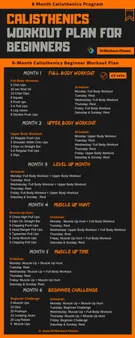
II. Calisthenics Workout Plan for Beginners: A Week-by-Week Guide
Week 1: Foundation Building
Begin with bodyweight exercises that focus on building a solid foundation. Start with 2-3 sets of 10-12 repetitions for each exercise.
Week 2: Progression and Intensity
Increase the intensity by adding more sets or repetitions to your exercises. Introduce variations like jumping squats, incline push-ups, and weighted dips.
Exercise | Sets | Repetitions |
|---|---|---|
Squats | 3 | 12-15 |
Push-ups | 3 | 10-12 |
Planks | 3 | 30-60 seconds hold |
Dips | 3 | 8-10 |
Pull-ups | 3 | 6-8 |
Week 3: Skill Development
Focus on developing advanced calisthenics skills like muscle-ups, handstands, and levers. Start with assisted versions and gradually progress to full movements.
- Muscle-ups (banded if needed)
- Handstands (against a wall for support)
- Levers (tuck lever, straddle lever)
Calisthenics Workout Plan for Beginners: A Week-by-Week Guide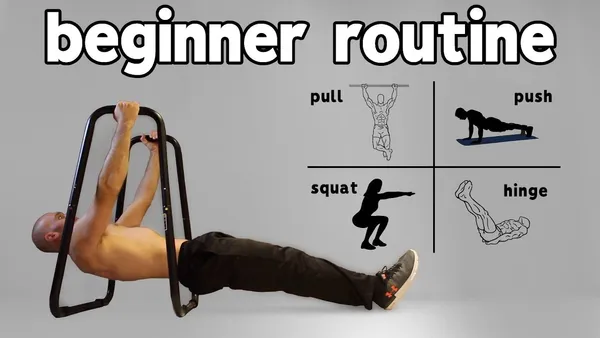
III. Calisthenics Progression for Beginners: How to Gradually Increase Difficulty
As you progress in your calisthenics journey, it's crucial to gradually increase the difficulty of your workouts to continue challenging your body and achieving results. A well-structured progression plan will help you safely and effectively advance your skills and abilities.
Here are some strategies for increasing the difficulty of your calisthenics workouts:
Start with the Basics
Start with the basics and master the fundamental movements before attempting more challenging exercises. This will provide a solid foundation and minimize the risk of injury.
Increase the Sets and Reps
Once you can comfortably perform a certain exercise with good form, gradually increase the number of sets and repetitions. This will progressively overload your muscles and stimulate growth.
Increase the Intensity
Increase the intensity of your workouts by reducing rest periods, adding weight (e.g., using a weighted vest), or performing exercises with a greater range of motion. This will challenge your muscles and improve your overall fitness.
- Benefits of Calisthenics
- Calisthenics Workout Plan for Beginners
- Calisthenics Exercises for Beginners
Try Advanced Variations
Explore advanced variations of exercises as you become stronger. For example, instead of regular push-ups, try decline push-ups or clap push-ups.
Incorporate Weighted Exercises
Adding weight to your calisthenics exercises can significantly increase the difficulty and provide a new stimulus for muscle growth. Use a weighted vest, backpack, or resistance bands to challenge yourself.
Exercise | Beginner | Advanced |
|---|---|---|
Push-ups | Regular push-ups | Decline push-ups |
Pull-ups | Assisted pull-ups | Weighted pull-ups |
Squats | Bodyweight squats | Weighted squats |
Use Resistance Bands
Resistance bands can provide additional resistance and make exercises more challenging. Attach them to a fixed object and use them to perform variations of exercises like rows, squats, and lunges.
Increase the Frequency
If you're ready for a greater challenge, consider increasing the frequency of your calisthenics workouts. Add an extra workout day or two to your week to accelerate your progress.
Train with a Partner
Training with a partner can provide motivation and accountability. Encourage each other to push your limits and try new exercises.
Remember, progression should be gradual and individualized. Listen to your body and rest when needed. By implementing these strategies, you can effectively increase the difficulty of your calisthenics workouts and continue to make progress in your fitness journey.
Calisthenics Progression for Beginners: How to Gradually Increase Difficulty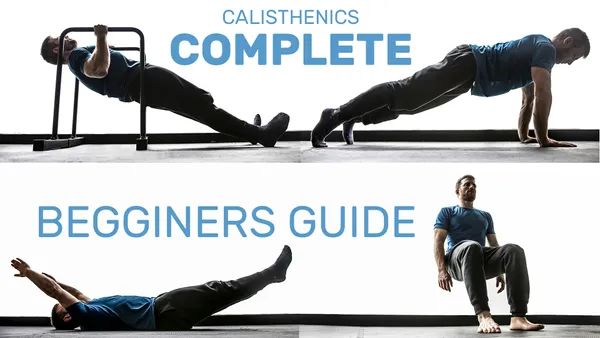
IV. Calisthenics Nutrition for Beginners: What to Eat to Fuel Your Workouts
Foods to Include in Your Diet
When it comes to fueling your calisthenics workouts, there are certain foods that you should make sure to include in your diet:
- Lean protein: Protein is essential for building and repairing muscle tissue. Good sources of lean protein include chicken, fish, beans, and tofu.
- Whole grains: Whole grains provide complex carbohydrates, which give you sustained energy throughout your workout. Good sources of whole grains include brown rice, quinoa, and oats.
- Fruits and vegetables: Fruits and vegetables are packed with vitamins, minerals, and antioxidants, which are essential for overall health and well-being.
Foods to Avoid
There are also certain foods that you should avoid or limit while training for calisthenics. These include:
- Processed foods: Processed foods are often high in unhealthy fats, sodium, and sugar. They can contribute to weight gain and inflammation, which can interfere with your workouts.
- Sugary drinks: Sugary drinks can spike your blood sugar levels and lead to energy crashes. They also contribute to weight gain and cavities.
- Excessive alcohol: Alcohol can dehydrate you and interfere with muscle recovery.
Sample Calisthenics Meal Plan
Here is a sample calisthenics meal plan that you can follow to get you started:
Meal | Options |
|---|---|
Breakfast | Oatmeal with fruit and nuts, eggs with whole-wheat toast, or Greek yogurt with granola |
Lunch | Salad with grilled chicken or fish, brown rice with beans and vegetables, or a whole-wheat sandwich with lean protein and vegetables |
Dinner | Grilled chicken or fish with roasted vegetables, quinoa with vegetables and lean protein, or lentil soup |
Snacks | Fruit, vegetables, nuts, or Greek yogurt |
Hydration
Hydration is crucial for calisthenics workouts. Aim to drink plenty of water throughout the day, especially before, during, and after your workouts.
With a healthy diet and proper hydration, your body will be better prepared to perform and recover from your calisthenics workouts, helping you achieve your fitness goals.
How to Do a Push-Up: The Ultimate GuideHow to Do a Pull-Up: Step-by-Step Guide for BeginnersHow to Do a Dip: Step-by-Step Tutorial for BeginnersHow to Do a Barbell SquatHow to Do a Plank: Beginner's Guide and Variations
Calisthenics Nutrition for Beginners: What to Eat to Fuel Your Workouts